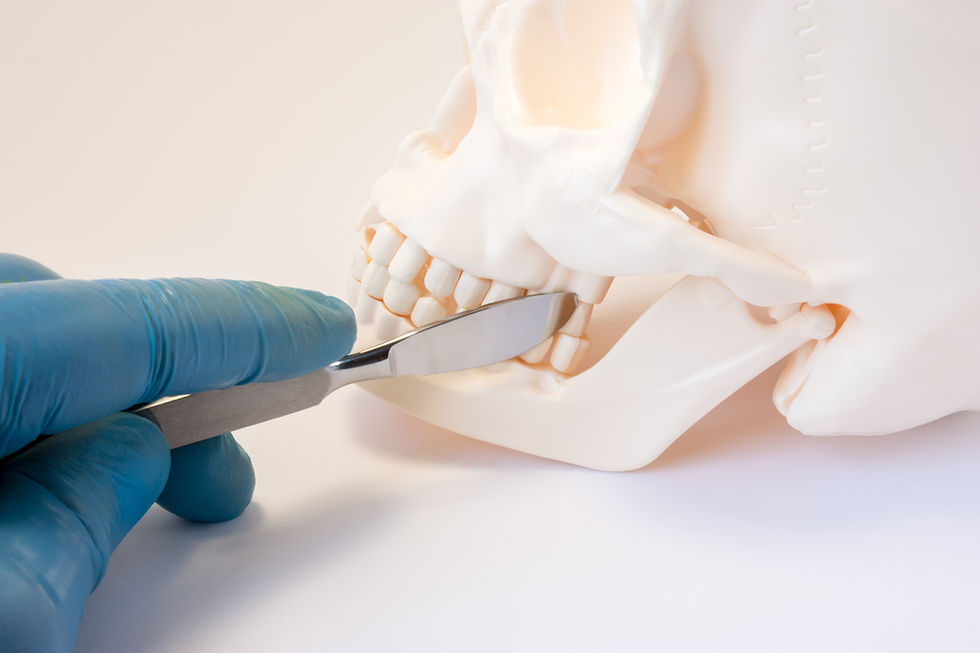
Common TMD Conditions
Temporomandibular disorders (TMDs) refer to a group of more than a dozen conditions that affect the jaw joint (TMJ) and the muscles involved in jaw movement. These disorders often lead to symptoms such as jaw pain, clicking or popping sounds, restricted movement, and difficulty with everyday activities like chewing, speaking, or yawning.
In this section, we explore some of the most common types of TMD and how a TMJ Physiotherapist can play a key role in managing symptoms and restoring normal jaw function.


Myogenous TMD (Muscle-Related Disorders)
These involve pain or dysfunction originating from the jaw muscles (masticatory muscles).
Common signs:
-
Muscle tenderness or tightness
-
Jaw fatigue or stiffness
-
Referred pain (e.g., headaches, neck pain)
-
Often associated with clenching, grinding, or stress-related tension

Arthrogenous TMD (Joint-Related Disorders)
These involve structural or functional issues within the temporomandibular joint itself.
Common signs:
-
Joint noises (clicking, popping, grinding)
-
Jaw locking (open or closed)
-
Pain localised to the TMJ
-
Restricted jaw movement

Mixed Involvement (Muscle + Joint Involvement)
A combination of both muscular and joint-related dysfunction. This is very common in clinical presentations.
Common signs:
-
Both muscle and joint pain
-
Movement limitations with joint noises
-
Higher symptom complexity and recurrence risk

TMD Classification” + Subtitle

Common TMJ-Related Conditions
Chronic muscle pain and tightness in the jaw, face, or neck, often caused by trigger points in the masticatory muscles.
Tightness or fatigue in the jaw muscles, commonly due to overuse, clenching, or poor posture.
Displacement or dysfunction of the small disc inside the TMJ, which may cause clicking, popping, or jaw locking.
Degenerative joint condition that leads to cartilage breakdown, joint pain, and limited jaw mobility.
Inability to fully open or close the jaw due to disc displacement or joint restriction.
Involuntary clenching or grinding of the teeth, often during sleep, placing excess stress on the TMJ and jaw muscles.
Inflammation of the TMJ capsule or joint lining, causing sharp pain, tenderness, and swelling during jaw movement.
A nerve-related condition causing sharp, electric-shock-like facial pain, sometimes mistaken for TMJ dysfunction.
Excessive joint movement, leading to instability, frequent clicking, and discomfort during wide mouth opening.
Previous injury to the jaw or face that affects joint alignment or muscle coordination, often resulting in chronic dysfunction.
Jaw irritation or muscular strain after prolonged mouth opening during dental work.
Inflammation or compression of the retrodiscal tissue (located behind the TMJ disc), often resulting in deep joint pain and limited jaw mobility, especially during closing.
Many TMD patients report ear fullness, tinnitus (ringing), or ear pain due to the close anatomical relationship between the TMJ and the auditory canal.
Tension or dysfunction in the TMJ and jaw muscles (particularly the temporalis and masseter) can refer pain into the temples or sides of the head, often mimicking tension-type headaches or migraines.


How Physiotherapy Helps
Physiotherapy plays a critical role in managing TMDs. Treatment may involve:
Manual Joint Mobilisation
Gentle, targeted techniques to improve jaw joint mobility, reduce stiffness, and relieve pain.
Soft Tissue Techniques
Hands-on therapy to release tight muscles around the jaw, face, and neck, reducing tension and improving circulation.
Jaw-Specific Exercises
Tailored strengthening and stretching exercises to improve jaw stability, control, flexibility, and movement coordination.
Postural Retraining Ergonomics
Correction of poor posture and workstation habits to reduce strain on the TMJ, neck, and shoulders—especially important for those who sit for long periods or clench unconsciously.
Dry Needling & Trigger Point Therapy
A targeted technique used to release deep muscle tension and deactivate trigger points in the jaw and neck muscles.
Education & Habit Awareness
Guidance to help you understand contributing behaviours—such as clenching, grinding, or poor breathing patterns—and how to manage or change them to support long-term recovery.”
By addressing underlying issues such as muscle imbalance, joint restriction, and poor movement patterns, TMJ physiotherapy can:
-
Relieve jaw pain and tension
-
Restore normal jaw function
-
Reduce clicking, locking, or stiffness
-
Improve your ability to eat, speak, and move with ease
-
Minimise recurrence of symptoms

